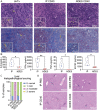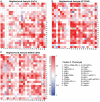Sustained Intratumoral Administration of Agonist CD40 Antibody Overcomes Immunosuppressive Tumor Microenvironment in Pancreatic Cancer
- PMID: 36658712
- PMCID: PMC10037694
- DOI: 10.1002/advs.202206873
Sustained Intratumoral Administration of Agonist CD40 Antibody Overcomes Immunosuppressive Tumor Microenvironment in Pancreatic Cancer
Abstract
Agonist CD40 monoclonal antibodies (mAb) is a promising immunotherapeutic agent for cold-to-hot tumor immune microenvironment (TIME) conversion. Pancreatic ductal adenocarcinoma (PDAC) is an aggressive and lethal cancer known as an immune desert, and therefore urgently needs more effective treatment. Conventional systemic treatment fails to effectively penetrate the characteristic dense tumor stroma. Here, it is shown that sustained low-dose intratumoral delivery of CD40 mAb via the nanofluidic drug-eluting seed (NDES) can modulate the TIME to reduce tumor burden in murine models. NDES achieves tumor reduction at a fourfold lower dosage than systemic treatment while avoiding treatment-related adverse events. Further, abscopal responses are shown where intratumoral treatment yields growth inhibition in distant untreated tumors. Overall, the NDES is presented as a viable approach to penetrate the PDAC immune barrier in a minimally invasive and effective manner, for the overarching goal of transforming treatment.
Keywords: drug delivery; immunotherapy; implantable device; pancreatic cancer; sustained release.
© 2023 The Authors. Advanced Science published by Wiley-VCH GmbH.
Conflict of interest statement
The authors declare no conflict of interest.
Figures








Similar articles
-
Potentiating Antitumor Efficacy Through Radiation and Sustained Intratumoral Delivery of Anti-CD40 and Anti-PDL1.Int J Radiat Oncol Biol Phys. 2021 Jun 1;110(2):492-506. doi: 10.1016/j.ijrobp.2020.07.2326. Epub 2020 Aug 5. Int J Radiat Oncol Biol Phys. 2021. PMID: 32768562 Free PMC article.
-
Nanofluidic drug-eluting seed for sustained intratumoral immunotherapy in triple negative breast cancer.J Control Release. 2018 Sep 10;285:23-34. doi: 10.1016/j.jconrel.2018.06.035. Epub 2018 Jul 3. J Control Release. 2018. PMID: 30008369
-
Neoadjuvant Selicrelumab, an Agonist CD40 Antibody, Induces Changes in the Tumor Microenvironment in Patients with Resectable Pancreatic Cancer.Clin Cancer Res. 2021 Aug 15;27(16):4574-4586. doi: 10.1158/1078-0432.CCR-21-1047. Epub 2021 Jun 10. Clin Cancer Res. 2021. PMID: 34112709 Free PMC article. Clinical Trial.
-
CD40 immunotherapy for pancreatic cancer.Cancer Immunol Immunother. 2013 May;62(5):949-54. doi: 10.1007/s00262-013-1427-5. Epub 2013 Apr 16. Cancer Immunol Immunother. 2013. PMID: 23589109 Free PMC article. Review.
-
Enhancing pancreatic cancer immunotherapy: Leveraging localized delivery strategies through the use of implantable devices and scaffolds.J Control Release. 2024 Sep;373:145-160. doi: 10.1016/j.jconrel.2024.07.023. Epub 2024 Jul 14. J Control Release. 2024. PMID: 38996923 Review.
Cited by
-
Enhanced safety and efficacy profile of CD40 antibody upon encapsulation in pHe-triggered membrane-adhesive nanoliposomes.Nanomedicine (Lond). 2025 Jan;20(2):155-166. doi: 10.1080/17435889.2024.2446008. Epub 2024 Dec 29. Nanomedicine (Lond). 2025. PMID: 39764733
-
Engineering platforms for localized long-acting immune modulation.J Allergy Clin Immunol. 2024 Mar;153(3):572-575. doi: 10.1016/j.jaci.2024.01.004. Epub 2024 Jan 20. J Allergy Clin Immunol. 2024. PMID: 38253261 Free PMC article. Review.
-
STING agonist inflames the cervical cancer immune microenvironment and overcomes anti-PD-1 therapy resistance.Front Immunol. 2024 Mar 14;15:1342647. doi: 10.3389/fimmu.2024.1342647. eCollection 2024. Front Immunol. 2024. PMID: 38550593 Free PMC article.
-
Intratumor injected gold molecular clusters for NIR-II imaging and cancer therapy.Proc Natl Acad Sci U S A. 2024 Jan 30;121(5):e2318265121. doi: 10.1073/pnas.2318265121. Epub 2024 Jan 23. Proc Natl Acad Sci U S A. 2024. PMID: 38261618 Free PMC article.
-
Intratumoral nanofluidic system enhanced tumor biodistribution of PD-L1 antibody in triple-negative breast cancer.Bioeng Transl Med. 2023 Sep 15;8(6):e10594. doi: 10.1002/btm2.10594. eCollection 2023 Nov. Bioeng Transl Med. 2023. PMID: 38023719 Free PMC article.
References
-
- a) Hiraoka N., Onozato K., Kosuge T., Hirohashi S., Clin. Cancer Res. 2006, 12, 5423; - PubMed
- b) Lutz E. R., Wu A. A., Bigelow E., Sharma R., Mo G., Soares K., Solt S., Dorman A., Wamwea A., Yager A., Laheru D., Wolfgang C. L., Wang J., Hruban R. H., Anders R. A., Jaffee E. M., Zheng L., Cancer Immunol. Res. 2014, 2, 616. - PMC - PubMed
Publication types
MeSH terms
Substances
Grants and funding
LinkOut - more resources
Full Text Sources
Medical
Research Materials
